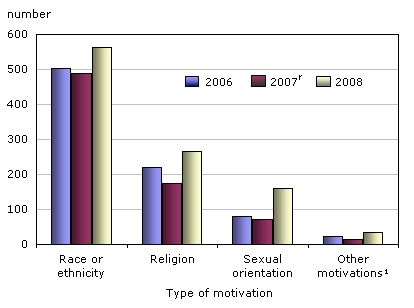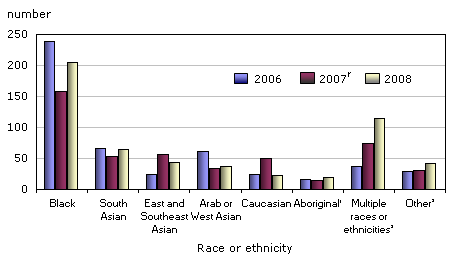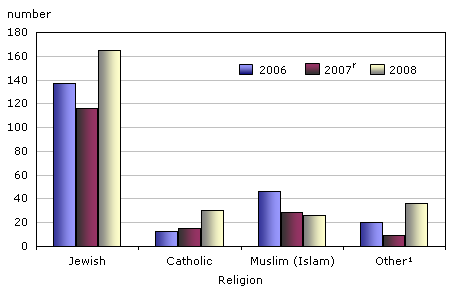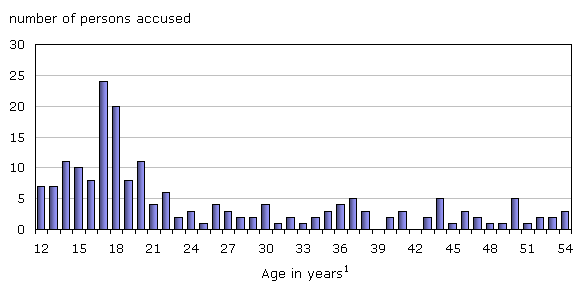Police-reported hate crime in Canada, 20081
Archived Content
Information identified as archived is provided for reference, research or recordkeeping purposes. It is not subject to the Government of Canada Web Standards and has not been altered or updated since it was archived. Please "contact us" to request a format other than those available.
By Mia Dauvergne
Hate crimes increase in 2008
Hate crime rate in the United States similar to Canada
Hate crime rates higher in census metropolitan areas
Hate crimes motivated by sexual orientation double
Blacks most commonly-targeted racial group
Jewish faith most commonly targeted religion
Hate crimes motivated by sexual orientation predominantly violent
Six in ten persons accused of hate crime are youth and young adults
Summary
Data Source
Detailed data tables
References
Notes
In Canada, and elsewhere in the world, hate crimes are regarded as a serious social problem (OSCE, 2009a). These types of incidents are considered to be different from other types of crime as their impact can have profound effects, not only upon victims, but also on their respective communities and on society itself (OSCE, 2009b).
There are four Criminal Code offences that are considered to be hate crimes: advocating genocide, public incitement of hatred, wilful promotion of hatred and mischief in relation to religious property. In addition, other offences, such as assaults or threats, may be classified as hate crimes if the incidents are determined to have been motivated by bias based upon race, national or ethnic origin, language, colour, religion, sex, age, mental or physical disability, sexual orientation or any other similar factor. For these types of offences, sentencing provisions allow for increased penalties beyond the usual range.2
Efforts to measure the incidence of hate crime have been made by many North American and European countries. While there are differences in the definitions and types of hate crimes collected, 42 member States of the Organization for Security and Cooperation in Europe (OSCE)3 compile at least some data on hate crimes in their respective countries (OSCE, 2009a). The detailed level of information collected in Canada and the extent of coverage is among the most comprehensive of these countries (OSCE, 2009a).
At Statistics Canada, information on hate crimes is collected via two complementary surveys: the Uniform Crime Reporting (UCR) survey and the General Social Survey (GSS) on victimization. The UCR survey is an annual survey that gathers information on hate-motivated crimes as defined by the Criminal Code that have been reported to, and substantiated by, police services. The GSS, which began collecting hate crime data in 1999, is conducted every five years and gathers information from Canadians who report having been the victim of a hate crime.4 The focus of this Juristat is on 2008 police-reported data.
It is important to note that the number of incidents presented in this report likely undercounts the true extent of hate crime in Canada as not all crimes are reported to police. Results from the 2004 GSS (the most recent information available) indicate that only about 40% of hate crimes were reported to authorities (Dauvergne et al. 2008). However, the proportion of these reported incidents deemed by police after investigation to be hate crimes is unknown.
Hate crimes increase in 2008
In 2008, Canadian police services, covering 88% of the population, reported 1,036 hate crimes.5 This number was up from 765 incidents in 2007 and 892 in 2006, the first year that near-national statistics on hate crimes were available from the UCR survey. Despite the 35% increase, hate crimes continued to account for a low proportion of all crimes, at less than 1%.
Information from police indicates that year-over-year changes do not necessarily reflect actual increases or decreases in the incidence of this type of offence since the number of hate crimes recorded in a given area can be influenced by many different factors. These may include the existence (or absence) of specialized police hate crime units, training initiatives, zero tolerance policies, victim assistance programs, hot-lines and community awareness campaigns. In other words, the rate of hate crime in a given area may be more indicative of reporting practices by the public and local police services rather than prevalence levels.
Hate crime rate in the United States similar to Canada
Although methodological differences do not enable a direct comparison to be made, it is interesting to see that the rate of police-reported hate crime in the United States is somewhat similar to that in Canada. In 2008, American police services covering 89% of the population reported 7,783 criminal incidents motivated by hate, representing a rate of 2.9 incidents per 100,000 population (FBI, 2009). This compares to Canada's rate of 3.5 incidents per 100,000 population.
Hate crime rates higher in census metropolitan areas
As a group, the 2008 rate of hate crime in Canada's census metropolitan areas (CMAs)6 was almost double the rate in non-census metropolitan areas (4.0 versus 2.4 per 100,000 population) (Table 1). That said, between 2007 and 2008, the rate of hate crime in non-CMAs increased to a much greater extent than in CMAs. Again, it is important to emphasize that geographical differences may be affected by policing and community practices.
Together, Toronto and Vancouver accounted for about 4 in 10 reported hate crimes in Canada. There were 271 incidents in Toronto, up by 8% from 2007. Vancouver reported 143 incidents in 2008, almost double the number reported the previous year. Montréal, on the other hand, reported a slight decrease in 2008 and one of the lowest rates in the country, with 38 hate crimes in 2008.
After adjusting for population, the highest rates of hate crime in 2008 were in the smaller CMAs of London, Guelph, Kingston and Brantford, followed by the larger cities of Vancouver, Hamilton and Kitchener (Chart 1). With the exception of Brantford, each of these areas recorded an increase in hate crimes in 2008. Few census metropolitan areas reported substantial decreases in hate crime.
Chart 1
Hate crimes reported by police, by census metropolitan area, 2008

Note: In 2008, coverage for each CMA exceeded 90% except for the following: Winnipeg (88%), Saskatoon (84%), Hamilton (75%), Barrie (70%) and Edmonton (70%). Excludes the CMAs of Moncton and Oshawa.
Source: Statistics Canada, Canadian Centre for Justice Statistics, Uniform Crime Reporting Survey.
Due to limited coverage in some areas of the country, provincial hate crime data are only available for Quebec, Ontario and British Columbia.7 Between 2007 and 2008, each of these provinces reported increases, up by 40%, 37% and 84% respectively (Text table 1). The rates in Ontario and British Columbia were three to four times higher than in Quebec.
| Province | 2007r | 2008 | Percent change in number from 2007 to 2008 | ||
|---|---|---|---|---|---|
| number | rate | number | rate | ||
| Quebec | 67 | 0.9 | 94 | 1.2 | 40 |
| Ontario | 459 | 3.6 | 629 | 4.9 | 37 |
| British Columbia | 104 | 2.4 | 191 | 4.4 | 84 |
|
r revised Note: Information reflects data reported by police services covering virtually 100% of the population in Quebec, Ontario and British Columbia. Source: Statistics Canada, Canadian Centre for Justice Statistics, Uniform Crime Reporting Survey. |
|||||
Hate crimes motivated by sexual orientation double
Three primary motivations surrounding police-reported hate crimes were identified in 2008: race or ethnicity (55%), religion (26%) and sexual orientation (16%). The remaining 3% of incidents were motivated by a variety of factors, such as sex, mental or physical disability and language. These proportions were similar to those reported by police in both 2007 and 2006 (Chart 2).
Chart 2
Hate crimes reported by police, by type of motivation, 2006, 2007 and 2008

1. Includes mental or physical disability, language, sex and other similar factors. Examples of "other similar factors" may include age or political beliefs.
Note: Data are based upon information reported by police services covering 88% of the population of Canada.
Source: Statistics Canada, Canadian Centre for Justice Statistics, Uniform Crime Reporting Survey.
Results from the 2004 GSS also show race or ethnic biases to be the most common motivation reported by those who had been victims of a hate crime (Dauvergne et al. 2008). Racial biases are also a common motivation for hate crimes reported by police in the United States (FBI, 2009) and across many European countries (OSCE, 2009a).
Although increases occurred among all three major categories of police-reported hate crime, those motivated by sexual orientation, predominantly homosexuality, rose the most (Table 2). There were 159 such hate crimes in 2008, about double the number reported in 2007 and 2006 (Chart 2). Among violent incidents in which a victim was identified, 15% were female.
There were 265 religiously-motivated hate crimes in 2008, up by 92 incidents or 53%. Racially-motivated hate crimes also increased in 2008, although to a lesser extent (up by 15%). There were 563 such incidents, 73 more than in 2007.
Among Canada's three largest CMAs, Toronto showed an increase in hate crimes motivated by religion and sexual orientation, but a decline in those motivated by race or ethnicity. Montréal showed a similar pattern, although the increases in hate crimes motivated by religion and sexual orientation were quite small. In Vancouver, however, increases were reported in all three categories of hate crime motivations.
CMAs differ not only in their number and rates of hate crimes, but also in the types of hate crime most commonly committed (Table 3). For example, a comparison of the 10 largest CMAs shows that while race or ethnicity was the most common type of motivation in each city, the proportions in Hamilton, Calgary and Edmonton were the highest. Kitchener recorded the highest proportion of religiously-motivated hate crimes while Québec and Vancouver had the highest proportions of hate crimes motivated by sexual orientation.
Blacks most commonly-targeted racial group
Incidents against Blacks represented the largest category of racially-motivated hate crimes (37%). In 2008, there were 205 hate crimes against Blacks, up by 47 incidents (or 30%) from the year before, although still lower than in 2006 (Chart 3).
Chart 3
Racially-motivated hate crimes reported by police, by type of race, 2006, 2007 and 2008

1. The number of hate crimes against Aboriginals may be under-reported due to the unavailability of data from police services in the territories and the northern part of the Prairie provinces where the proportion of the Aboriginal population is highest.
2. Includes hate crimes that target more than one race or ethnicity.
3. Includes other motivations based upon race or ethnicity not otherwise stated (e.g. Latin American, South American).
Note: Data are based upon information reported by police services covering 88% of the population of Canada.
Source: Statistics Canada, Canadian Centre for Justice Statistics, Uniform Crime Reporting Survey.
The number of racially-motivated hate crimes against South Asians (including East Indian and Pakistani groups), the next most commonly targeted racial group, also increased in 2008, up by 11 incidents (or 21%). In contrast, incidents against Caucasians and East and Southeast Asians (including Chinese, Japanese, Vietnamese groups) decreased, down by 28 and 13 incidents respectively. The number of hate crimes that targeted multiple racial or ethnic groups increased from 2007, up by 40 incidents (or 53%).
Police reported 20 hate crimes against Aboriginals, 6 more than the year before. It is important to note that the number of hate crimes against Aboriginals may be under-reported due to the unavailability of data from police services in the territories and the northern part of the Prairie provinces where the proportion of the Aboriginal population is highest.
Jewish faith most commonly targeted religion
As in previous years, the majority (64%) of religiously-motivated hate crimes in 2008 involved crimes against the Jewish faith. These types of incidents increased by 42%, up from 116 in 2007 to 165 in 2008 (Chart 4). Anti-Semitic biases were cited by OSCE member countries as one of the most common hate crime motivations, along with race or ethnicity (OSCE, 2009a).
Chart 4
Religiously-motivated hate crimes reported by police, by type of religion, 2006, 2007 and 2008

1. Includes other motivations based upon religions not otherwise stated (e.g. Sikh, Hindu, and Buddhist).
Note: Data are based upon information reported by police services covering 88% of the population of Canada.
Source: Statistics Canada, Canadian Centre for Justice Statistics, Uniform Crime Reporting Survey.
The number of hate crimes committed against the Catholic faith doubled from 15 to 30 incidents in 2008. There were 26 incidents against the Muslim faith, three less than the year before. Motivations based upon other religions (such as Sikh, Hindu and Buddhist) also increased, up as a group by 27 incidents.
Hate crimes motivated by sexual orientation predominantly violent
Detailed information on the type and nature of offences associated with hate crimes is available from a subset of police services. Non-violent incidents, primarily mischief (Chart 5), accounted for about 6 in 10 hate crimes in 2008 and violent crimes for 4 in 10. While the proportion of violent hate crimes was higher in 2008 than in 2007 (33%), the 2007 figure was based upon a smaller subset of police services.8
Chart 5
Hate crimes reported by police, by type of offence, 2008

1. Includes, for example, defamatory libel.
Note: Data are based upon information reported by police services covering 49% of the population of Canada. Counts are based upon the most serious offence in the incident. One incident may involve multiple violations.
Source: Statistics Canada, Canadian Centre for Justice Statistics, Uniform Crime Reporting (UCR2.2) Survey.
In 2008, 75% of incidents motivated by sexual orientation involved a violent offence, usually minor assault, similar to previous years. In comparison, 38% of racially-motivated hate crimes and 25% of religiously-motivated hate crimes were classified by police as violent.
Homicide data differ from other crime data in that information on hate as a motivation has been available since 1991 as part of the Homicide Survey. Since then, there have been 22 hate-motivated homicides, including two in 2008. About half of all victims were killed because of biases related to sexual orientation and half due to race or ethnicity. There have been no religiously-motivated homicides reported by police since this information became available.
Six in ten persons accused of hate crime are youth and young adults
In general, a disproportionate number of youth and young adults are accused of crime. This is particularly the case for crimes motivated by hate. In 2008, 59% of persons accused of committing a hate-motivated crime were between 12 and 22 years of age compared to 38% of those accused of crime in general (Chart 6). The peak age of those accused of hate crime was 17 and 18 years. Most accused persons were male (88%), similar to the finding for crime in general.
Chart 6
Persons accused of hate crimes reported by police, by age, 2008

1. Excludes 7 accused persons age 55 years or older.
Note: Data are based upon information reported by police services covering 49% of the population of Canada.
Source: Statistics Canada, Canadian Centre for Justice Statistics, Uniform Crime Reporting (UCR2.2) Survey.
Victims of hate crime in 2008 tended to be a little older than accused persons. In 2008, the average age of victims was 32 years compared to 27 years for accused persons. As with accused persons, however, three-quarters of victims were males.
Summary
In 2008, Canadian police services reported 1,036 hate-motivated crimes, up from 765 in 2007. This represented an increase of 35%. Changes in the number of police-reported hate crimes can vary considerably from year-to-year due to increased awareness by the public as well as improved policing practices. Over the past three years, the vast majority of hate crimes have stemmed from one of three motivations: race/ethnicity, religion or sexual orientation, each of which increased in 2008. Non-violent offences, usually mischief, were the most common type of offences in 2008. About 6 in 10 persons accused of hate crime were between 12 and 22 years of age, the majority of whom were male.
Data source
Uniform Crime Reporting Survey
The incident-based Uniform Crime Reporting (UCR2) Survey is a microdata survey that captures detailed information on crimes reported to and substantiated by police, including the characteristics of victims, accused persons and incidents. In response to changing information needs, the survey was modified in 2005 (UCR 2.2) to enable the identification of incidents motivated by hate based on race, national or ethnic origin, language, colour, religion, sex, age, mental or physical disability, sexual orientation or any other similar factor (such as political beliefs). In 2008, police services reporting to the UCR 2.2 Survey covered 52% of the population of Canada.
A supplemental survey was conducted in 2006, 2007 and 2008 as a means of obtaining information on hate-motivated crimes from those police services reporting UCR 2 data but who had not yet converted their electronic reporting systems to the newer UCR 2.2 version. These respondents were asked to identify those criminal incidents that had been motivated by hate and to manually provide the detailed characteristics of each incident to Statistics Canada.
Combined, coverage from the UCR 2.2 Survey and the supplemental survey in 2008 is estimated at 88% of the population of Canada. The RCMP, outside of British Columbia, were unable to provide information. In addition, a small number of police services still reporting to the old aggregate version of the UCR survey, were also unable to respond.
Detailed data tables
Table 1 Hate crimes reported by police, by census metropolitan area, 2007 and 2008
Table 2 Hate crimes reported by police, by type of motivation, Canada, 2007 and 2008
References
Dauvergne, Mia, Scrim, Katie and Brennan, Shannon. 2008. "Hate Crime in Canada, 2006". Statistics Canada Catalogue no. 85F0033M. Canadian Centre for Justice Statistics. No. 17.
www.statcan.gc.ca/pub/85f0033m/85f0033m2008017-eng.htm
(accessed March 15, 2010).
Federal Bureau of Investigation (FBI). 2009. "Hate Crime Statistics, 2008". Uniform Crime Report. U.S. Department of Justice.
www.fbi.gov/ucr/hc2008/index.html (accessed March 15, 2010).
Organization for Security and Cooperation in Europe (OSCE). 2009a. "Hate Crime in the OSCE Region – Incidents and Responses: Annual Report for 2008". Office for Democratic Institutions and Human Rights. Warsaw, Poland.
www.osce.org/odihr (accessed February 26, 2010).
Organization for Security and Cooperation in Europe (OSCE). 2009b. "Hate Crime Laws: A Practical Guide". Office for Democratic Institutions and Human Rights. Warsaw, Poland.
www.osce.org/odihr (accessed February 26, 2010).
Notes
- The collection of police-reported hate crime data as well as the production of this analytical report is supported by funding from Citizenship and Immigration Canada.
- Criminal Code , R.S.C 1985, c. C-46, s.718.2(a)(i).
- The Organization for Security and Co-operation in Europe (OSCE) is the world's largest regional security organization with 56 participating states. Canada has been a member of the OSCE since 1973. For further information see the OSCE website, www.osce.org/.
- At the time of this report, the most recent information on hate crime available from the GSS is from 2004. Results from the 2009 cycle are expected in summer 2010.
- In 2008, hate crime data were collected from all municipal and provincial police services as well as the Royal Canadian Mounted Police (RCMP) in British Columbia. The RCMP, who provide policing services to all provinces and territories (except Quebec and Ontario), were unable to report hate crime data outside of British Columbia due to on-going changes in their electronic reporting system.
- A census metropolitan area (CMA) consists of one or more neighbouring municipalities situated around a central core. A CMA must have a total population of at least 100,000 of which 50,000 or more live in the core. To be included in the CMA, other adjacent municipalities must have a high degree of integration with the central core, as measured by commuting flows derived from census data. A CMA typically comprises more than one police service.
- Provincial analysis is limited due to the unavailability of data from the RCMP outside of British Columbia.
- The 2008 data are based upon information reported by police services covering 49% of the population whereas the 2007 data covered 22% of the population.
- Date modified:
